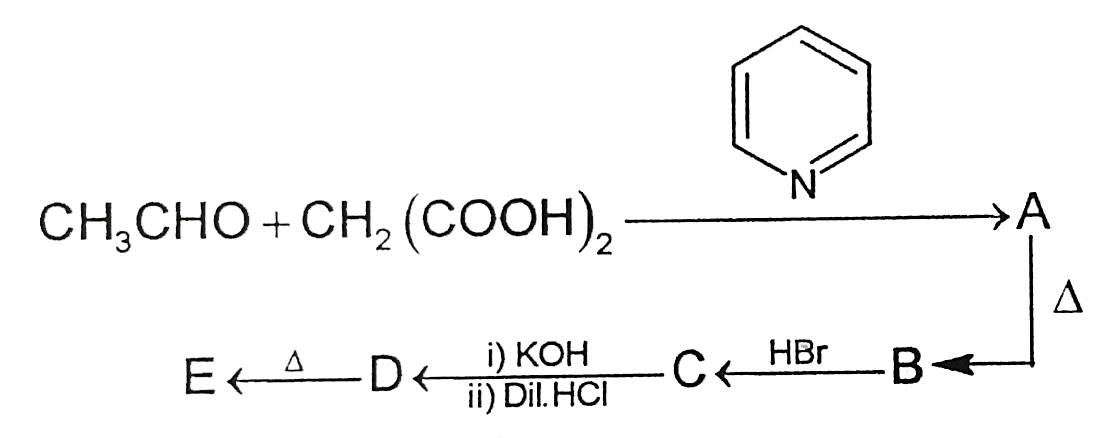Calculate the number of isomeric halopropanes produced, when propane gets chlorinated is:
1
2
3
4
The correct Answer is:B
To calculate the number of isomeric halopropanes produced when propane (C3H8) is chlorinated, we can follow these steps:
Step 1: Understand the Structure of Propane
Propane has the molecular formula C3H8, and its structure can be represented as:
HHH|||H−−C−−C−−C−−H|||HHH
This means propane has three carbon atoms, and each carbon is bonded to hydrogen atoms.
Step 2: Identify Possible Chlorination Sites
When chlorination occurs, chlorine can replace one of the hydrogen atoms. There are three carbon atoms in propane, and chlorination can occur at different positions:
1. At the terminal carbon (C1)
2. At the middle carbon (C2)
Step 3: Determine the Isomers Formed
1. Chlorination at the terminal carbon (C1):
- The product will be 1-chloropropane (CH3-CH2-CH2Cl).
2. Chlorination at the middle carbon (C2):
- The product will be 2-chloropropane (CH3-CHCl-CH3).
Step 4: Count the Isomers
From the above analysis, we have identified two distinct isomeric products:
1. 1-chloropropane
2. 2-chloropropane
Thus, the total number of isomeric halopropanes produced when propane is chlorinated is 2.
Final Answer
The number of isomeric halopropanes produced when propane gets chlorinated is 2.
---
Propane has the molecular formula C3H8, and its structure can be represented as:
HHH|||H−−C−−C−−C−−H|||HHH
This means propane has three carbon atoms, and each carbon is bonded to hydrogen atoms.
When chlorination occurs, chlorine can replace one of the hydrogen atoms. There are three carbon atoms in propane, and chlorination can occur at different positions:
1. At the terminal carbon (C1)
2. At the middle carbon (C2)
1. Chlorination at the terminal carbon (C1):
- The product will be 1-chloropropane (CH3-CH2-CH2Cl).
- The product will be 2-chloropropane (CH3-CHCl-CH3).
From the above analysis, we have identified two distinct isomeric products:
1. 1-chloropropane
2. 2-chloropropane
The number of isomeric halopropanes produced when propane gets chlorinated is 2.
Topper's Solved these Questions
- SAMPLE PAPER 04BOOK - EDUCART PUBLICATIONCHAPTER - SAMPLE PAPER 04EXERCISE - SECTION C
6 Videos
- SAMPLE PAPER 04BOOK - EDUCART PUBLICATIONCHAPTER - SAMPLE PAPER 04EXERCISE - SECTION C
6 Videos
- SAMPLE PAPER 02BOOK - EDUCART PUBLICATIONCHAPTER - SAMPLE PAPER 02EXERCISE - SECTION - C
6 Videos
- SAMPLE PAPER 05BOOK - EDUCART PUBLICATIONCHAPTER - SAMPLE PAPER 05EXERCISE - SECTION-C
6 Videos
Similar Questions
Knowledge Check
Calculate the number of monochloro derivatives that formed when neo-pentane is chlorinated?
A1B2C3D4Number of monochloro derivatives obtained when neo-pentane chlorinated
AoneBtwoCthreeDfourTwo mirrors at an angle θ∘ produce 5 images of a point. The number of images produced when θ is decreased to θ∘−30∘ is
A9B10C11D12
Calculation OF number OF geometrical isomerism
View SolutionCalculation OF number OF geometrical isomerism
View SolutionNumber of isomeric products obtained when 2-chlorobutane is heated with alcohol KOH is
View SolutionThe number of isomers obtained on monochlorination of propane
View SolutionCalculate the number of atoms present in 7.1 g of chlorine ?
View Solution

